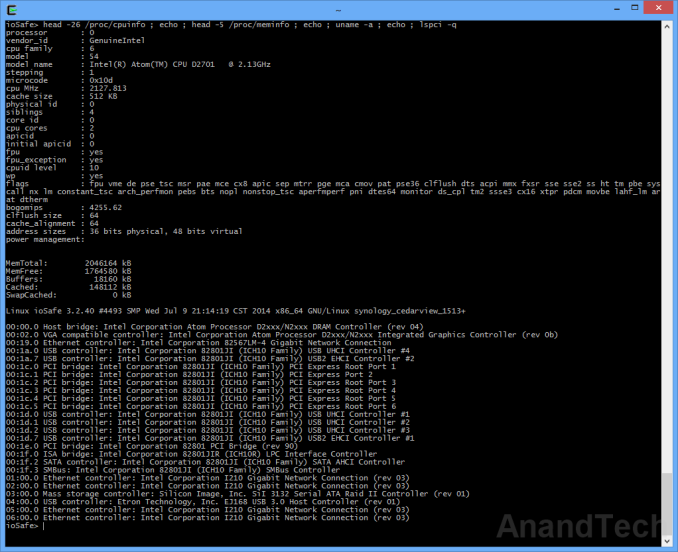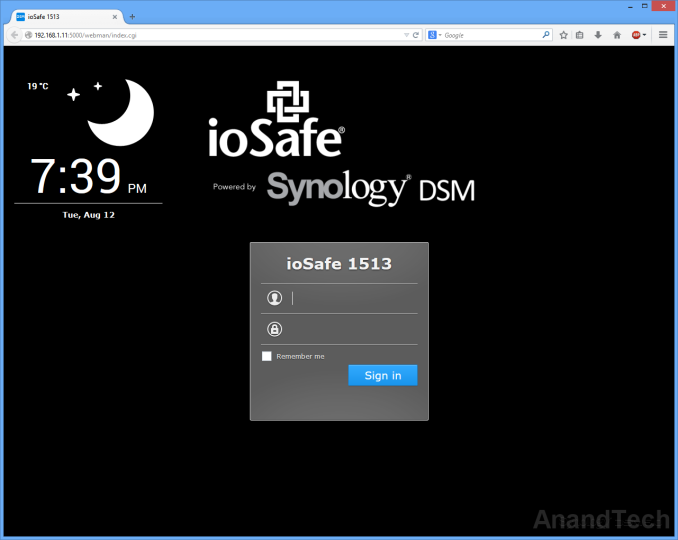ioSafe 1513+ Review: A Disaster-Resistant Synology DS1513+
by Ganesh T S on August 13, 2014 7:30 AM EST- Posted in
- NAS
- Storage
- Synology
- Enterprise
- ioSafe
Chassis Design and Hardware Platform
The Synology DS1513+ has been around for more than a year now. ioSafe announced the disaster-resistant version back at CES and tentatively set the shipment date for March. However, it wasn't until late July that the design was finally perfected. Compared to the SoloPRO and the ioSafe 214 platforms, the 1513+ is quite different when it comes to power consumption and thermal requirements. Tackling the heat dissipation was one of the main challenges faced by ioSafe in the product development process.
ioSafe uses three main patented technologies in disaster-proofing the 1513+:
- HydroSafe: Waterproofing by placement of drives in a metal cage sealed with rubber gaskets.
- DataCast: Fireproofing by surrounding the drive cage with a super-saturated gypsum structure
- FloSafe: Vents in the gypsum structure to allow for cooling during normal operation.
ioSafe has a technology brief explaining how these are applied in the 1513+. It is reproduced below:
In traditional NAS units / storage arrays, the arrangement of the fans has to ensure that air flows across the surface of the drives in order to cool it down. This is not directly possible in the ioSafe NAS designs because the hard drives are inside a waterproof sealed chamber. Ambient air is not designed to enter the waterproof chamber, but, through the fireproof door and to the outside of the extrusion. For cooling purposes, the design relies on a combination of conduction (from the drives to the extrusion) and convection (from the extrusion to the ambient air flowing over the extrusion). Note that the waterproof front door of the drive cage as well as the fireproof front face are essential parts of the cooling mechanism. Without these, the airflow across the serrated drive cage might not be enough to draw away the heat through the fans.
On the software front, the ioSafe 1513+'s Synology DSM is based on a Linux kernel (v 3.2.40). The interesting aspects of the hardware platform can be gleaned after accessing the unit over SSH.
Note that the unit has four Intel I210 GbE NICs connected via PCIe. The USB 3.0 ports are from an Etron EJ168 PCIe x1 to 2x USB 3.0 bridge,while a SiI 3132 PCIe x1 to 2x eSATA host controller with port multiplier support enable the two eSATA ports (to which the expansion chassis units get attached). Since the system utilizes the ICH10 I/O controller hub (this is the standard Cedarview storage platform that Intel promoted a few generations back), all the SATA ports for the drive bays come off the hub without the need for any bridge chips.
Our review unit came with the drives pre-initialized in a SHR volume (1-disk fault tolerance). ioSafe has a special wallpaper for the web UI, but, other than that there is no customization - all DSM features that one might get after initializing the unit from a diskless configuration are available in the pre-installed version also.
We have covered DSM 5.0's setup and usage impressions in our recent DS214play and DS414j reviews. There is not much point in rehashing the same excellent setup and usage experience. That said, each of those reviews concentrated on a particular DSM aspect, and this review will be no different. After the sections presenting the performance numbers, we will take a detailed look at the iSCSI features of DSM 5.0.













43 Comments
View All Comments
bkleven - Friday, August 15, 2014 - link
Most modern safes have a small hole in the back for cabling, which is usually intended to bring electricity into the safe to power humidity control equipment (and that is usually just a heater). When you are forced to place a safe in a location that is not climate controlled it's pretty important to prevent condensation from occurring anywhere inside.I've never looked into the impact that hole has on fire protection (I presume there is some impact) but obviously flooding is an issue unless you spay foam it or use some sort of grommet.
bsd228 - Monday, August 18, 2014 - link
Cannon, for example, provides power and a cat 5 connection on most of their safes. It's not a problem.Beany2013 - Saturday, August 16, 2014 - link
I doubt the floor of my flat is rated to half a ton of spot weight. Nor that of most SOHO offices in houses or houses converted to office buildings (as with a lot of small town businesses).It's a pretty practical solution, though, I'll grant you, if your floor is rated for it.
robb.moore - Monday, August 18, 2014 - link
Engineers have another word for power supplied into perfectly insulated boxes - "ovens" :)Great for baking bread, not so good for computers.
Plus, if it gets hot enough inside, it'll actually cause the insulation to kickoff prematurely rendering the safe useless in a fire. It's a non-trivial balance between heat produced during normal operation and heat resistance during a fire event. DIY and proceed with caution.
Robb Moore, CEO
ioSafe Inc.
Essence_of_War - Wednesday, August 13, 2014 - link
Nice review! I certainly don't think I could roll my own one of these!I had a question about some of the time scales you present in the misc/concluding remarks section.
Have you considered testing/reporting RAID1 or RAID10 rebuild times? Or are they so much (and consistently so) faster than the RAID5 times that it isn't particularly interesting?
Gigaplex - Wednesday, August 13, 2014 - link
How does a device like this ensure good thermal transfer such that the hard drives don't overheat under regular use, while still giving good thermal isolation so they don't melt in the event of a fire?jmke - Wednesday, August 13, 2014 - link
well they have active cooling, check the cooling fans. In case of fire you can see that white stuff "DataCast Insulation" will keep the heat of the fire under control, converting to gas (and thereby taking up the heat)I tested the smaller brother (ioSafe 214) with fire and water and filmed it. http://www.madshrimps.be/articles/article/1000593/...
others have put them in cars , houses, etc https://www.youtube.com/watch?v=OygRpR4qtcM and the drives survive.
During normal operation the active cooling keeps the drive well within the safe limits.
If you want to enjoy data disaster recovery service make sure that you take HDDs from the qualified lists.
you can also just launch up Ubuntu and mount the Synology drives like this to copy your data.
ideal would be a second unit to just plug and play the drives...
Herschel55 - Wednesday, August 13, 2014 - link
Folks, a normal DS1513+ diskless on Amazon is $780. This is $1600, more than twice the amount. For this price I would invest in a true DR solution that mirrored a normal DS1513+ to a cloud service like S3 or Glacier, or even another DS1513+ offsite. The latest Synology DSM supports all of the above and the strategy covers ALL disasters, natural or otherwise.Gigaplex - Wednesday, August 13, 2014 - link
This is a 5 bay device, which is usually configured in a RAID5 equivalent. With 4-6TB drives, that's 16-24TB capacity. Finding a cloud provider and Internet uplink capable of transferring that amount of data in a reasonable timeframe is not trivial.robb.moore - Thursday, August 14, 2014 - link
You're right in the mark Gigaplex. With this unit, 90TB is possible with 2 expansion bays. For people concerned about recovering quickly, it can take months (maybe a year?) to stream 90TB back. And for many cloud providers, they might offer to ship a single HDD back but not an entire array.Robb Moore, CEO
ioSafe Inc.